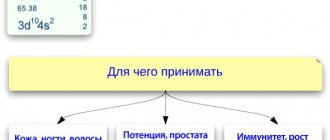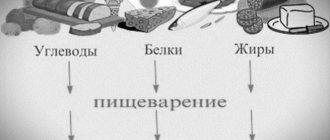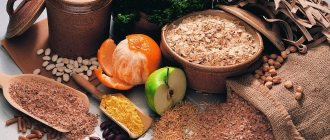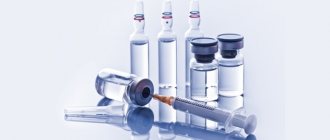A tale about carbohydrate metabolism in the human body, about the causes of malfunctions in the body, about how you can improve carbohydrate metabolism and whether this malfunction can be treated with pills. I explained everything in this article. Go!
- You, Ivan Tsarevich, don’t look at me. I'm wolf. I'm supposed to eat only meat. All kinds of herbs and fruits and vegetables are important for humans. Without them you will have neither strength nor health...
Hello friends! A lot has been said about how important carbohydrate metabolism is in the human body, but nothing is more forgotten than the truisms. Therefore, without describing complex biochemistry, I will briefly tell you the main thing that under no circumstances should be thrown out of your head. So, read my presentation and remember it!
Friends, read the article further, there will be a lot of interesting things in it!
And for those who want:“DO YOU FIND OUT WHAT IS KEEPING YOU FROM LOSSING WEIGHT?”
Take the TEST .
Classification
Depending on their structure, there are several groups of carbohydrates.
Monosaccharides are small molecules that are not broken down in the digestive tract. These are glucose, fructose, galactose.
Disaccharides are small carbohydrate molecules that are broken down into two monosaccharides in the digestive tract. For example, lactose is divided into glucose and galactose, sucrose is divided into glucose and fructose.
Polysaccharides are large molecules consisting of hundreds of thousands of monosaccharide residues (mainly glucose) linked together. This is starch, meat glycogen.
Carbohydrates and diets
The breakdown time of polysaccharides in the digestive tract differs, which depends on their ability to dissolve in water. Some polysaccharides are broken down quickly in the intestines. Then the glucose obtained from their breakdown quickly enters the blood. Such polysaccharides are called “fast”. Others are less soluble in the aqueous environment of the intestine, so they break down more slowly, and glucose enters the blood more slowly. Such polysaccharides are called “slow”. Some of these elements are not broken down at all in the intestines. They are called insoluble dietary fiber.
Usually, the term “slow or fast carbohydrates” does not mean the polysaccharides themselves, but foods that contain them in large quantities.
The list of carbohydrates - fast and slow - is presented in the table.
| Fast carbohydrates | Slow carbohydrates |
| fried potatoes | Bran bread |
| White bread | Unprocessed rice grains |
| Mashed potatoes | Peas |
| Honey | Cereals |
| Carrot | Buckwheat |
| Cornflakes | Rye bread with bran |
| Sugar | Freshly squeezed fruit juice without sugar |
| Muesli | Wholemeal pasta |
| Chocolate | Red beans |
| Boiled potatoes | Dairy |
| Biscuit | Fresh fruits |
| Corn | bitter chocolate |
| White rice | Fructose |
| Black bread | Soybeans |
| Beet | Green vegetables, tomatoes, mushrooms |
| Bananas | — |
| Jam | — |
When choosing products for a diet, a nutritionist always relies on a list of fast and slow carbohydrates. Fast in combination with fats in one product or meal leads to fat deposition. Why? A rapid increase in blood glucose stimulates the production of insulin, which provides a supply of glucose in the body, including the pathway for the formation of fat from it. As a result, when eating cakes, ice cream, and fried potatoes, you gain weight very quickly.
Digestion
From a biochemical point of view, carbohydrate metabolism occurs in three stages:
- Digestion. It begins in the oral cavity during the process of chewing food.
- The actual metabolism of carbohydrates.
- Formation of final metabolic products.
Carbohydrates are the basis of the human diet. According to the formula for rational nutrition, food should contain 4 times more of them than proteins or fats. The need for carbohydrates varies from person to person, but on average, a person needs 300-400 g per day. Of these, about 80% comes from starch in potatoes, pasta, cereals, and 20% from fast carbohydrates (glucose, fructose).
The metabolism of carbohydrates in the body also begins in the oral cavity. Here, the salivary enzyme amylase acts on polysaccharides - starch and glycogen. Amylase hydrolyzes (breaks down) polysaccharides into large fragments - dextrins, which enter the stomach. There are no enzymes that act on carbohydrates, so dextrins in the stomach do not change in any way and pass further along the digestive tract, ending up in the small intestine. Here, several enzymes act on carbohydrates. Pancreatic juice amylase hydrolyzes dextrins to the disaccharide maltose.
Specific enzymes are secreted by the cells of the intestine itself. The enzyme maltase hydrolyzes maltose to the monosaccharide glucose, lactase hydrolyzes lactose to glucose and galactose, sucrase hydrolyzes sucrose to glucose and fructose. The resulting monoses are absorbed from the intestines into the blood and enter the liver through the portal vein.
Stages of carbohydrate breakdown
Processing of food, the main component of which is the carbohydrate component, occurs in different parts of the digestive tract.
— the beginning of splitting occurs in the oral cavity. During the act of chewing, food is processed by the salivary enzyme pitalin (amylase), which is synthesized by the parotid glands. It helps the huge starch molecule break down into smaller polymers.
- since food is in the oral cavity for a short time, it requires subsequent processing in the stomach. Once in the stomach cavity, carbohydrate products are mixed with the secretion of the pancreas, namely pancreatic amylase, which is more effective than oral amylase, and therefore after 15-30 minutes, when chyme (semi-liquid incompletely digested stomach contents) from the stomach reaches In the duodenum, almost all carbohydrates are already oxidized to very small polymers and maltose (a disaccharide, two connected glucose molecules).
- from the duodenum, a mixture of polysaccharides and maltose continues its amazing journey to the upper intestines, where their final processing is carried out by the so-called enzymes of the intestinal epithelium. Enterocytes (cells that line the microvilli of the small intestine) contain the enzymes lactase, maltase, sucrase and dextrinase, which carry out the final processing of disaccharides and small polysaccharides into monosaccharides (this is already one molecule, but not yet glucose). Lactose breaks down into galactose and glucose, sucrose into fructose and glucose, maltose, like other small polymers, into glucose molecules, and it instantly enters the bloodstream.
— from the bloodstream, glucose enters the liver and, subsequently, glycogen is synthesized from it (a polysaccharide of animal origin, performs a storage function, and is simply necessary for the body when it needs to quickly obtain a large amount of energy).
The role of the liver in carbohydrate metabolism
This organ ensures the maintenance of a certain level of glucose in the blood due to the reactions of synthesis and breakdown of glycogen.
In the liver, reactions of interconversion of monosaccharides take place - fructose and galactose are converted into glucose, and glucose can be converted into fructose.
In this organ, gluconeogenesis reactions occur - the synthesis of glucose from non-carbohydrate precursors - amino acids, glycerol, lactic acid. The hormone insulin is also neutralized here using the enzyme insulinase.
Glucose metabolism
Glucose plays a key role in the biochemistry of carbohydrate metabolism and in the overall metabolism of the body, since it is the main source of energy.
The blood glucose level is constant and ranges from 4 to 6 mmol/l. The main sources of this element in the blood are:
- Carbohydrates of food.
- Liver glycogen.
- Amino acids.
Glucose is used in the body for:
- energy generation,
- glycogen synthesis in the liver and muscles,
- amino acid synthesis,
- fat synthesis.
A story about why you can’t choose one and ignore the other
So we found out that the most important monosaccharide is glucose. It is she who provides our body with energy reserves. Then why can’t you eat only it, and spit on all the other carbohydrates? There are several reasons for this.
- In its pure form, it is immediately absorbed into the blood, causing a sharp jump in sugar. The hypothalamus gives a signal: “Reduce to normal!” The pancreas releases a portion of insulin, which restores the balance by sending excess to the liver and muscles in the form of glycogen. And so again and again. Very quickly, the gland cells wear out and stop functioning normally, which will lead to diabetes and other serious complications that will no longer be correctable.
- The predator has the shortest digestive tract, and synthesizes the carbohydrates needed for energy supply from the same remnants of protein molecules. He's used to it. Our human gastrointestinal tract is structured somewhat differently. We should receive carbohydrate foods, in the amount of about half of all nutrients, including dietary fiber, which helps peristalsis and provides food for beneficial bacteria in the colon. Otherwise, we are guaranteed constipation and putrefactive processes with the formation of toxic waste.
- The brain is an organ that cannot store energy reserves like muscles or the liver. For its operation, a constant supply of glucose from the blood is necessary, and more than half of the entire liver glycogen supply goes to it. For this reason, under significant mental stress (scientific activity, passing exams, etc.), he may crave “sweets.” This is a normal, physiological process.
- For the synthesis of proteins in the body, not only glucose is needed. The remnants of polysaccharide molecules provide the necessary fragments for the formation of the “building elements” we need.
- Along with plant foods, we receive vitamins and other useful substances that can also be obtained from animal foods, but without dietary fiber. And we have already found out that our intestines really need them.
There are other equally important reasons why we need all sugars, not just monosaccharides.
Natural source of energy
Glucose is a universal source of energy for all cells of the body. Energy is needed to build your own molecules, contract muscles, and generate heat. The sequence of glucose conversion reactions leading to the release of energy is called glycolysis. Glycolysis reactions can occur in the presence of oxygen, then we speak of aerobic glycolysis, or in oxygen-free conditions, then the process is anaerobic.
During the anaerobic process, one molecule of glucose is converted into two molecules of lactic acid (lactate) and energy is released. Anaerobic glycolysis produces little energy: one molecule of glucose produces two molecules of ATP, a substance whose chemical bonds accumulate energy. This method of obtaining energy is used for short-term work of skeletal muscles - from 5 seconds to 15 minutes, that is, while the mechanisms for supplying muscles with oxygen do not have time to turn on.
During aerobic glycolysis reactions, one molecule of glucose is converted into two molecules of pyruvic acid (pyruvate). The process, taking into account the energy spent on its own reactions, produces 8 ATP molecules. Pyruvate enters into further oxidation reactions - oxidative decarboxylation and the citrate cycle (Krebs cycle, tricarboxylic acid cycle). As a result of these transformations, 30 ATP molecules are released per glucose molecule.
Glycogen exchange
The function of glycogen is to store glucose in the cells of the animal body. Starch performs the same function in plant cells. Glycogen is sometimes called animal starch. Both substances are polysaccharides, built from repeatedly repeating glucose units. The glycogen molecule is more branched and compact than the starch molecule.
Metabolism processes in the body of the carbohydrate glycogen occur especially intensively in the liver and skeletal muscles.
Glycogen is synthesized within 1-2 hours after eating when blood glucose levels are high. To form a glycogen molecule, a primer is needed - a seed consisting of several glucose residues. New residues in the form of UTP-glucose are sequentially added to the end of the primer. When the chain grows by 11-12 residues, a side chain of 5-6 similar fragments is added to it. Now the chain coming from the primer has two ends - two points of growth of the glycogen molecule. This molecule will lengthen and branch many times as long as the blood glucose concentration remains high.
Between meals, glycogen breaks down (glycogenolysis), releasing glucose.
Obtained from the breakdown of liver glycogen, it goes into the blood and is used for the needs of the whole body. Glucose obtained from the breakdown of glycogen in muscles is spent for the needs of muscles only.
When does fat breakdown occur?
Our body needs food to provide it with energy. As we have already figured out, the body stores energy in the form of glycogen or fat deposits. Our body constantly needs energy: for the functioning of internal organs, ensuring all systems and functions, for digesting food, for physical activity.
In a passive state and during sleep, our body expends much less energy than during physical activity. This is why we need to move a lot to burn energy efficiently.
Also, the body’s energy consumption increases when thermoregulation is necessary (if it is necessary to warm the body at an external cold temperature) and during the recovery of the body after illness and injury.
This explains the fact that in the cold season our body spends more energy than in the summer under the same conditions - the energy goes to warming the body. And after illness, a lot of energy goes into restoring the body, hence the loss of body weight after serious illness - the body has used up part of its fat reserves as an energy source.
In any case, our body begins to spend energy from fat reserves only if it is not enough. Therefore, an important point in losing weight is ensuring a calorie deficit. When less energy is consumed than consumed, energy reserves - glycogen and fat - are used.
Glycogen from muscles is used primarily by muscles. That is, during physical activity, be it sports or physical work, glycogen reserves in the muscles are first used up, and only then, when they are insufficient, fat begins to be consumed.
This is why short workouts often do not lead to results in weight loss - the body simply takes energy only from glycogen reserves, and it does not reach fat reserves. To prevent this from happening, workouts should last about an hour: then glycogen will be spent and fat will begin to break down.
It is worth considering that a very large calorie deficit can lead to the opposite effect. The body will perceive this situation as hunger and will be forced to take a defensive position - it will slow down the metabolism so that fat reserves are not used up so intensively. His task is to preserve as much energy reserves as possible in order to withstand the hunger to which you have doomed him.
Therefore, if you want to lose weight, do not frighten your body with hunger and do not force it to defend itself (after all, our instinct of self-preservation is the most important and paramount). The optimal daily calorie deficit for weight correction is 15-20% of the daily caloric intake. This is quite enough to systematically and confidently lose excess weight without causing harm or stress to the body.
Formation of glucose from non-carbohydrate precursors - gluconeogenesis
The body only has enough energy stored in the form of glycogen for a few hours. After a day of fasting, this substance does not remain in the liver. Therefore, during low-carbohydrate diets, complete fasting, or during prolonged physical work, normal blood glucose levels are maintained due to its synthesis from non-carbohydrate precursors - amino acids and lactic acid glycerol. All these reactions occur mainly in the liver, as well as in the kidneys and intestinal mucosa. Thus, the metabolic processes of carbohydrates, fats and proteins are closely intertwined.
Glucose is synthesized from amino acids and glycerol during fasting. In the absence of food, tissue proteins break down into amino acids, fats into fatty acids and glycerol.
Glucose is synthesized from lactic acid after intense physical activity, when it accumulates in large quantities in the muscles and liver during anaerobic glycolysis. From the muscles, lactic acid is transferred to the liver, where glucose is synthesized from it, which is returned to the working muscle.
Useful variety
In other articles, I have already reported that all sources of carbohydrates are divided into mono-, di-, tri-, oligo- and polysaccharides. Only simple ones can be absorbed from the intestinal tract; complex ones must first be broken down into their component parts.
Pure monosaccharide is glucose. It is responsible for the level of sugar in our blood, the accumulation of glycogen as “fuel” in the muscles and liver. It gives strength to muscles, ensures brain activity, and forms energy molecules ATP, which are used for the synthesis of proteins, enzymes, digestive processes, cell renewal and removal of waste products.
Diets for various diseases sometimes include a complete abstinence from carbohydrates, but such effects can only be short-term, until a therapeutic effect is achieved. But you can regulate the process of losing weight by reducing carbohydrates in food, because too many reserves is just as bad as too little.
Regulation of carbohydrate metabolism
This process is carried out by the nervous system, endocrine system (hormones) and at the intracellular level. The task of regulation is to ensure a stable level of glucose in the blood. Of the hormones that regulate carbohydrate metabolism, the main ones are insulin and glucagon. They are produced in the pancreas.
The main task of insulin in the body is to reduce blood glucose levels. This can be achieved in two ways: by increasing the penetration of glucose from the blood into the body’s cells and increasing its use in them.
- Insulin ensures the penetration of glucose into the cells of certain tissues - muscle and fat. They are called insulin-dependent. Glucose enters the brain, lymphatic tissue, and red blood cells without the participation of insulin.
- Insulin enhances the use of glucose by cells by:
- Activation of glycolytic enzymes (glucokinase, phosphofructokinase, pyruvate kinase).
- Activation of glycogen synthesis (due to increased conversion of glucose into glucose-6-phosphate and stimulation of glycogen synthase).
- Inhibition of gluconeogenesis enzymes (pyruvate carboxylase, glucose-6-phosphatase, phosphoenolpyruvate carboxykinase).
- Increased inclusion of glucose in the pentose phosphate cycle.
All other hormones that regulate carbohydrate metabolism are glucagon, adrenaline, glucocorticoids, thyroxine, growth hormone, ACTH. They increase blood glucose levels. Glucagon activates the breakdown of glycogen in the liver and the synthesis of glucose from non-carbohydrate precursors. Adrenaline activates the breakdown of glycogen in the liver and muscles.
Carbohydrate metabolism in the human body: a chain of transformations
Carbohydrate metabolism in the human body (CM) begins when you put carbohydrate-containing food in your mouth and begin to chew it. There is a useful enzyme in the mouth - amylase. It begins the breakdown of starch.
Food enters the stomach, then into the duodenum, where an intensive breakdown process begins, and finally into the small intestine, where this process continues and the finished monosaccharides are absorbed into the blood.
Most of it settles in the liver, being converted into glycogen - our main energy reserve. Glucose easily penetrates into liver cells. Glycogen also accumulates in muscles, but to a lesser extent. To penetrate the cell membranes into myosites, you need to spend some energy. And there isn't enough space there.
But muscle loads help penetration. An interesting effect occurs: muscle glycogen is quickly used up during physical activity, but at the same time, it is easier for new replenishment to leak through cell membranes and accumulate in the form of glycogen.
This mechanism partly explains the development of physical endurance in our muscles during sports. Until we train our muscles, they are not able to accumulate much energy “in reserve.”
Glycogen is consumed in anaerobic or aerobic breakdown. In the first case, ATP is manufactured from it (1 molecule of glucose produces 2 molecules of adenosine triphosphoric acid), which are broken down into water and carbon dioxide with the release of energy. In the second, lactic acid is formed, the excess of which is sent to the liver, where ATP can be formed from it again in the Cori cycle.
These biochemical reactions are quite complex, but their essence is approximately the same - to provide us with the strength to live.
Some intermediate products of the process are used to synthesize substances and compounds necessary for the body. Excess carbohydrates stimulate the pancreas to produce insulin and the result of this process is fat deposition.
Exchange disorders. Hypoglycemia
The most common disorders of carbohydrate metabolism are hypo- and hyperglycemia.
Hypoglycemia is a condition of the body caused by low blood glucose levels (below 3.8 mmol/l). The reasons may be: a decrease in the flow of this substance into the blood from the intestines or liver, an increase in its use by tissues. Hypoglycemia can result from:
- Liver pathologies are a violation of glycogen synthesis or the synthesis of glucose from non-carbohydrate precursors.
- Carbohydrate starvation.
- Prolonged physical activity.
- Kidney pathologies are a violation of the reabsorption of glucose from primary urine.
- Digestive disorders are pathologies of the breakdown of carbohydrates in food or the process of glucose absorption.
- Pathologies of the endocrine system - excess insulin or lack of thyroid hormones, glucocorticoids, growth hormone (GH), glucagon, catecholamines.
The extreme manifestation of hypoglycemia is hypoglycemic coma, which most often develops in patients with type I diabetes mellitus with an overdose of insulin. Low blood glucose leads to oxygen and energy starvation of the brain, which causes characteristic symptoms. It develops extremely quickly - if the necessary actions are not taken within a few minutes, the person will lose consciousness and may die. Typically, patients with diabetes are able to recognize the signs of a drop in blood glucose and know what to do - drink a glass of sweet juice or eat a sweet bun.
Hyperglycemia
Another type of carbohydrate metabolism disorder is hyperglycemia, a condition of the body caused by persistently high levels of glucose in the blood (above 10 mmol/l). The reasons may be:
- pathologies of the endocrine system. The most common cause of hyperglycemia is diabetes mellitus. There are type I and type II diabetes mellitus. In the first case, the cause of the disease is insulin deficiency caused by damage to the pancreatic cells that secrete this hormone. Damage to the gland is most often autoimmune in nature. Type II diabetes mellitus develops with normal insulin production and is therefore called non-insulin-dependent; but insulin does not perform its function - it does not carry glucose into the cells of muscle and fat tissue.
- neuroses and stress activate the production of hormones - adrenaline, glucocorticoids, the thyroid gland, which increase the breakdown of glycogen and the synthesis of glucose from non-carbohydrate precursors in the liver, inhibit glycogen synthesis;
- liver pathologies;
- binge eating.
In biochemistry, carbohydrate metabolism is one of the most interesting and extensive topics for study and research.
The role of glucose and insulin in carbohydrate metabolism
To ensure vital functions, the human body requires energy, which is produced through the complex process of converting carbohydrates, in particular glucose. The main source of glucose entering the blood is food that contains carbohydrates such as lactose, sucrose, starch and others. Typically, most of these carbohydrates are converted into glucose during digestion.
Glucose is a simple sugar consisting of six carbon atoms and is an important source of energy for the entire body and the only one for the brain. In a free state, glucose is practically not present in foods, but it is part of sucrose and starch, from which it is released during digestion, giving the body the necessary energy.
Carbohydrates included in food supply the body with about 60% of energy. Once in the gastrointestinal tract, complex carbohydrates are broken down by enzymes into simple molecules called monosaccharides, which are then absorbed into the blood. Monosaccharides include glucose, galactose and fructose. Of all monosaccharides, 80% belongs to glucose, in addition, most of the galactose and fructose are also converted into glucose during digestion. As a result, all carbohydrates supplied with food are broken down into glucose during metabolism.
Glucose can serve as a source of energy only when functioning inside the cell. Every cell in the body stores energy through the metabolic oxidation of glucose to carbon dioxide and water. Under the influence of this process, the energy accumulated in the glucose molecule is used to form an energy-intensive compound - the ATP molecule. The energy contained in the ATP molecule can subsequently be used by the body to carry out chemical intracellular reactions.
Having penetrated into cells, glucose takes on a central metabolic role, supplying energy to many biochemical reactions necessary for cellular functions. The brain, unlike other tissues, is not capable of synthesizing glucose and its energy needs depend entirely on the supply of glucose from the blood. For the brain to function normally, the blood glucose level must be at least 3.0 mmol/l. However, it should not be too high. Since glucose is an osmotically active substance, when its level in the blood increases, in accordance with the laws of osmosis, water begins to flow from the tissues into the blood, and the kidneys begin to actively remove glucose if its level reaches 10 mmol/l. As a result, the body is deprived of glucose, its main source of energy.
Let's talk about how glucose gets inside cells. As a result of digestion and complex carbohydrate metabolism, there is an increased glucose content in the blood. This serves as a kind of signal to the pancreas to produce enzymes and hormones.
Pancreatic cells have different structures and perform different functions. There are so-called beta cells that synthesize the hormone insulin. When the level of glucose in the blood increases, insulin is released into the blood, opening a kind of gateway for it to enter the cells, where it can subsequently be used by the body as a source of energy. But the cells of the body need constant energy supply, and not just during meals, so normal insulin secretion in a healthy person occurs constantly with an indicator of 0.5-1 per hour.
Eating food stimulates additional insulin release. Moreover, this happens almost instantly, which does not lead to an increase in blood sugar levels. Between meals, the body also needs energy material in the form of glucose, and for this, the liver reserves the required amount of carbohydrates, processed into glycogen, and converts it back to glucose as needed.
One of the functions of the pancreas is to regulate blood glucose levels. For this purpose, two antagonist hormones are produced in its cells: insulin and glucagon. That is, if there is a lot of glucose in the blood, insulin rushes to carry it inside the cells, and the energy surplus is stored in glycogen with the help of the liver. If there is little glucose in the blood, glucagon blocks the production of glycogen, beginning to actively convert it back into glucose to provide the body with the necessary energy supply. Thus, due to the normal functioning of the pancreas, the maintenance of blood glucose levels is strictly controlled.
In addition to regulating carbohydrate metabolism, the role of insulin in the normal functioning of the body cannot be overestimated. Insulin is the only hormone that helps glucose entering the blood pass through liver, fat and muscle cells. If there is not enough insulin, then approximately the same thing happens that can happen to a car; To start the fuel combustion process, you need to turn on the ignition, but it does not work, and fuel floods the engine. Insulin performs the ignition function in the body. If there is not enough of it, glucose is not burned, is not processed into energy, but accumulates in the blood and disrupts the functioning of the entire body. Insulin hunger occurs in the midst of sugar abundance.
In addition, insulin helps the liver in the formation of reserve energy reserves of glycogen, plays a huge role in ensuring the body’s energy balance, preventing the conversion of amino acids into sugars, improves protein synthesis, promotes the conversion of carbohydrates into fats, that is, it is involved in almost all vital processes. If, after processing glucose and deposition of glycogen in the liver, the blood sugar level remains high, then fat cells convert the excess into fat, which, accordingly, leads to obesity.
However, with a long, incorrectly formulated diet, with a large amount of “fast” carbohydrates and refined foods, the functioning of the pancreas can be disrupted. This threatens the development of such a serious disease as diabetes. If cells cannot absorb glucose that enters the blood during food digestion, then its level gradually increases. There are two types of diabetes. Type I (insulin dependent) requires the introduction of insulin into the body from the outside, since the pancreas practically does not produce insulin. In type II (non-insulin dependent), enough insulin is produced, but it does not work properly. Since the cells do not receive the required amount of energy, weakness and rapid fatigue occur.
If the blood sugar level is above 10 mmol/l, then the kidneys are connected to its removal from the body. As urine output increases, a feeling of constant thirst appears. Eventually, the body switches to other types of fuel: fats and proteins. But their breakdown also occurs under the influence of insulin, which is sorely lacking, so fats are not completely burned, which leads to poisoning of the entire body and can provoke a coma.
Therefore, in order to maintain health, it is necessary to carefully monitor the quality of the diet and, above all, carbohydrates. There is such a thing as the glycemic index (GI) of foods. It shows how quickly a particular product is broken down and converted into glucose in the body. Moreover, the faster the breakdown, the higher the glycemic index. So-called “fast” carbohydrates cause the pancreas to react by releasing a record amount of insulin. Consumption of “fast” carbohydrates always leads to the development of obesity, since the body will certainly store excess glucose as fat. The situation is completely different with “slow” carbohydrates, which, gradually breaking down, allow insulin to evenly transport glucose into the cells, providing a long-term feeling of satiety and the necessary energy supply.
Thus, the process of carbohydrate metabolism occurs in two directions: the conversion of nutrients into energy and the redistribution of their excess into energy reserves for fuel between meals. If the energy reserve is full, and there is still glucose in the blood, then the body stores it as a fat reserve. Therefore, it is very important to fuel the body with energy by consuming “slow” carbohydrates. With proper functioning of the digestive system and pancreas, blood sugar levels will always remain normal, helping to maintain health and an active lifestyle.
Author: Arina Mikhailova











